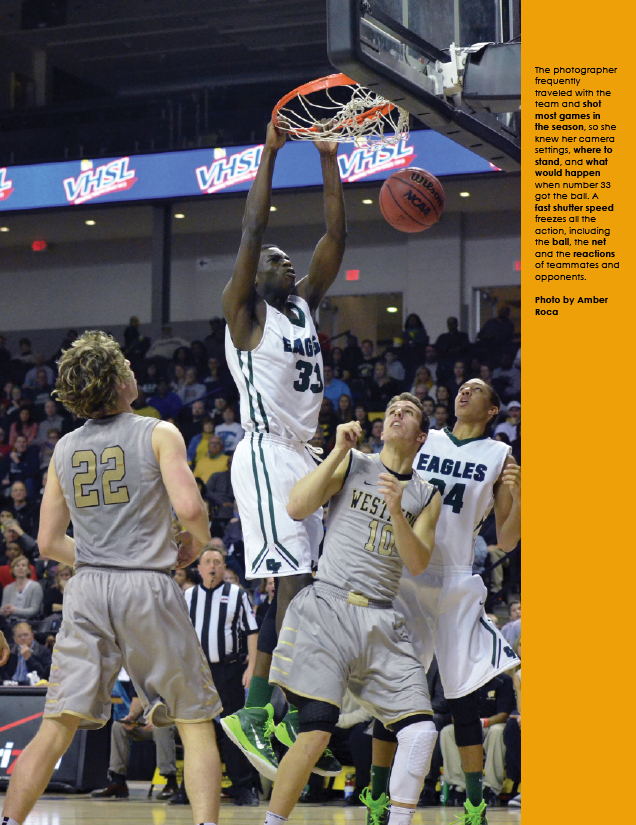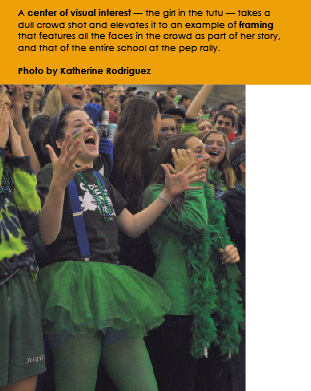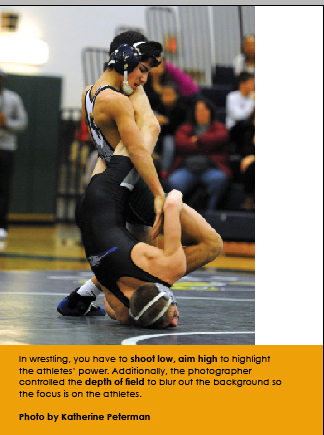
Putting action into your action photos
Written by Tiffany Kopcak
Great yearbooks make their schools look cool, not by featuring the “cool” kids but by capturing the excitement that comes with being involved. From warm-ups to rehearsals, game-winning plays to playing with puppets, students are constantly doing. Photographers need to be where the action is and ready to capture the moments that matter.
1. Take lots of photos, spend lots of time.
Get to your assignment early so you have time to prep your camera and determine the settings for the location. Determine where the action will take place, where the light is coming from and who the main people are. Be sure to stay for the full event, and don’t stop shooting. Maybe 20 in 100 pictures will be decent, and one in 100 might be great.
2. Go to practice, so you can be in the right place at the right time.
There’s nothing worse than seeing a great moment and not being ready for it. When you go to a practice, you find out when those pinnacle moments will be: when the actress gets pie in the face or the goalie and defender chest bump after every blocked goal.
Your best photos could come from practice when there’s less pressure on you and the players. At practice, the photographer is freer to move around to compose great shots. However, talk to coaches so you know where you can and cannot be. Do shoot from the sidelines, not the stands. Don’t use flash.
For plays and choir performances, plan on shooting dress rehearsals instead of actual performances. You may be able to get right up to the stage and even add additional light, which you could not do during a performance.
Don’t use autofocus. Set your focus to manual and let the action come to you, especially for track, cheer and gymnastics. The camera will focus on the wall behind the athlete instead of the athlete, or will take so long focusing that you’ll miss the shot. So, whenever you can, use manual focus.
4. Shoot low, aim high.
Look to the pros: professional sports photographers are almost always on their knees on the sidelines. Shooting low and aiming high makes athletes look bigger and more powerful. It will also help you to fill the frame.
And, keep the ball in the picture.
5. Think of reactions as actions.
No matter how small or large the action, like winning a point in Jeopardy Review or winning the state championship, reactions tell a story of triumph, defeat, connections, joy and feelings. In addition to shooting the action, be sure to turn the camera to the audience, fans, teammates and others to see their reactions.
6. Know your camera and use it properly.
If you have absolutely no idea what aperture, shutter speed and ISO do to a photo, put your camera on sports mode and follow everything else on this list; you’ll be fine. Otherwise, remember you need a fast shutter speed to freeze action (if you go higher than 640, prepare for your pictures to get dark).
Use a slower shutter speed to blur hands or feet — never faces — to show action in a photo.
Choose a big lens to bring the action to you. Not all 200mm zoom lenses are equal — choose the one with the widest opening: 67mm will get you better shots than  52mm.
52mm.
As long as you are making adjustments, remember to set the white balance when you are in the gym to get rid of that nasty yellow tint.
7. Remember to apply the rules of composition.
As you get better with capturing the moments, start paying attention to your composition. Look for leading lines. Compose using the rule of thirds, and frame your athlete with storytelling details or negative space.
When taking photos of action in groups, such as a pep rally, make sure you still have a center of visual interest. One person’s action framed by a crowd is way more usable than just the crowd.
8. Talk to teachers to find action in the classroom.
Make sure academic spreads are assigned early in the year so staff members have time to find great stories and opportunities to take photos. Games, group work, labs, projects and presentations all provide action to shoot. Alternately, go for random strolls. Sometimes you’ll find great action happening in the classrooms.
Comments are closed.


